As a tribute to one of the real pioneers of dressage, and a gifted and articulate proponent of the classical principles, we re-print this article that first appeared in THM in 1986. Tomorrow we go to one of Tina’s clinics…
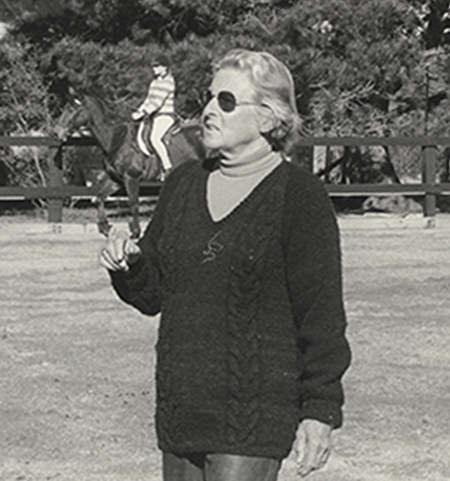
Tina Wommelsdorf has long been one of Australia’s most successful riders, dressage trainers, instructors and judges … but for Tina, her arrival in Australia was somewhat of a rude shock. So much so, that for several years after her arrival in Australia, Tina did not ride at all! Competing instead, and placing at a National level in Snow Skiing.
Tina came to Australia complete with a superb equestrian background, having spent ten years at the German Riding School, where she trained with both Felix Burkner and Albert Rother.
“After the War, Albert Rother was considered the best man for work in-hand,” Tina recalls, “He had an accident and damaged his pelvis, and could only ride sidesaddle. As a child of twelve or thirteen, I was given the opportunity to ride his top horses astride for him. It was my good fortune to learn in his stable on both showjumpers and dressage horses.”
“We came to Australia on a business trip and I looked around and the existing riding schools were so bad, that I couldn’t bring myself to ride. After several years, I decided to buy a horse. My main interest was in cross country and jumping. I didn’t even know Franz Mairinger existed.”
“Of course, in Germany we had to do dressage before we were let loose on the jumping horses, but I was not wrapped up in dressage. I wanted to jump Trossach, the mare I had bought, but the jolly thing had such an uneven temperament that I had to do more and more flat training… and we ended up competing at Dressage- winning the two Top Tests at Sydney on our first time out. So our career was decided for us.”
Tina took the mare, Trossach on to the Intermediate II standard, and was Horse and Rider of the Year – despite problems with the mare’s temperament.
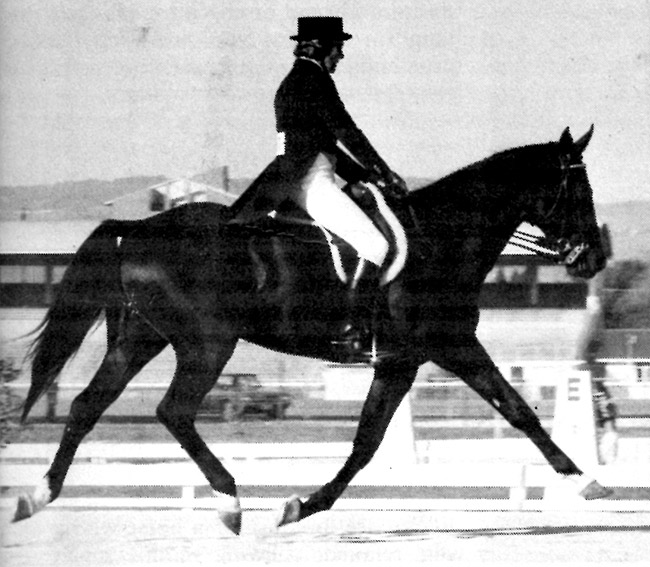
Tina and Jackpot – they won the first Australian Grand Prix
But it was on her second horse, Jackpot, that Tina competed in, and won, the first Grand Prix Dressage Test ever held in Australia … and went on to win Horse and Rider of the Year for two more years. Tina also won the top tests at the Championships and Sydney Royal, on both horses.
At the first National Dressage Championships, Tina won the three top tests, and again, in ’78, prior to her planned departure for the World Championship. In fact, Tina won 76 FEI tests in the years she rode her mare Trossach and Jackpot – until the poisoning of Jackpot ended her victorious road.
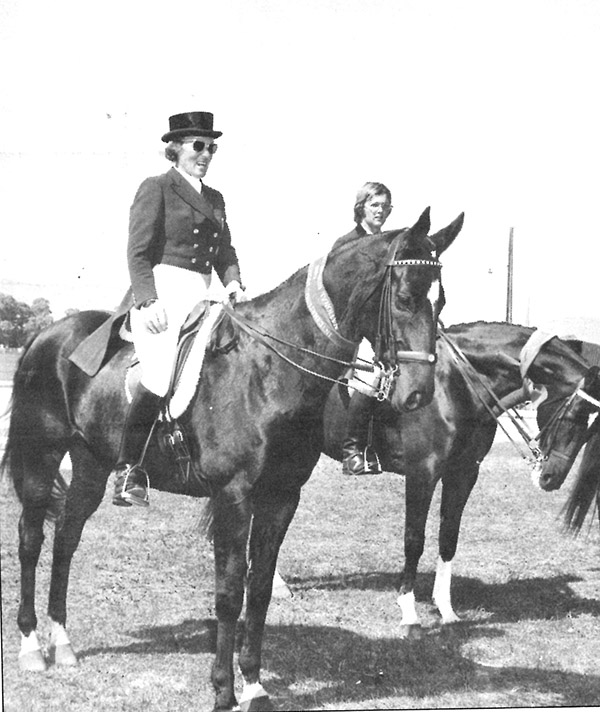
While Tina was still working Trossach, she met that great horseman, Franz Mairinger, who could explain things in a nutshell. Learning from Franz in those days was not easy. Just getting a lesson was difficult enough.
“I had to beg the EFA for a few private lessons, and never had more than three. Franz was always being sent here or there. It was sad that he was wasted on schools that other people could have easily taken. One time, at the opening of the Bowral Training Centre, we had an Advanced school, and when only three top horses came, the class was filled with Pony Club mothers and Franz spent all his time with a mother who couldn’t canter on the correct lead… ”
Jackpot was a five year old New Zealand Thoroughbred when Tina acquired him. He was broken in by top New Zealand race horse trainer, Eric Ropeha. Tina’s friend, Duncan Holden, President of the New Zealand Horse Society, saw him, “and sent me a telegram saying that he was the horse I should have as he had just so much movement, so I bought him unseen.”
“Jackpot was from a particular line of New Zealand Thoroughbreds that are all great movers, but all great spooks – God, he could shy! I literally rode him backwards from the stables to the arena for three months. If you got stuck into him, he could really buck – he was a fighter of the first order. I didn’t mind riding him backwards, as long as I won in the end, I don’t believe in fighting a horse. I seek his co-operation, and that is what I did.”
“Jackpot was a great natural mover. I’ve seen him, and the mare, Trossach, in the paddock, just playing, doing flying changes every stride.”
It took time, but eventually, Jackpot settled down to the job in hand:
“I’m a great believer in making their work fun. I’d take him out around Kuringai Chase, jumping little logs, down to Smith Creek, and up again- a drop of 600 vertical feet, and excellent exercise. I wouldn’t ride a top dressage horse in eventing, but they must pop over a few little logs for fun. Any self respecting horse has to have equal schooling in the basics of all three disciplines.”
“Jackpot was always so well balanced that he never slipped. Jackpot raised literally thousands of dollars for RDA with his demonstrations, and at some demonstrations, even in deep mud, he could do Piaffe and canter pirouettes. I think it helps their balance to work over undulating country – having to work things out for themselves.”
In the last few years Tina has not been so lucky in her choice of horses. Two prospects are now in the paddock on permanent holiday. “One from New Zealand turned out to be buckjumper; the other raced for six years and he couldn’t get that out of his system – he was dangerous. So we are looking for some new horses,” Tina says.
But while Tina Wommelsdorf may not be competing at the moment, she is still very active helping other riders and their horses. Tina recently visited Victoria at the invitation of Paul Johnson to take a school at Ambrodie Park in Coldstream.
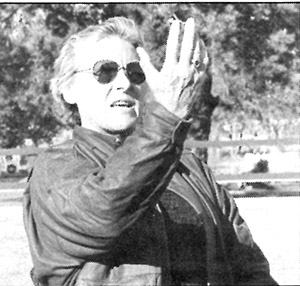
Tina is not only an extremely knowledgeable instructor, she also has an infectious enthusiasm, and that rare ability to get the message through to her pupils of both the two and four legged variety. The message is deceptively simple.
It is a message that is at the heart of every horseman’s program: The horse must move forward!
Again and again, Tina cajoles her students: “Don’t jam, keep it alive, keep it alive. Forward is that line that goes from your elbow to the horse’s mouth not just up. Make sure you ride him into the bit. Make sure you keep the engagement- because that is everything.”
The horses are being asked to relax and go long, but not to fall on their forehand, “When he comes too low, push him forward, don’t correct with your hand – only half halts, so you can keep on pushing. Say to your hands, ‘Don’t interfere’, don’t make heavy weather of it. Get him to relax with the bit. Fiddle with the bit, move the bit without moving the horse’s head – let the horse chew the bit. Don’t saw the mouth, gently talk to him through your hands … ”
“Push the horse so he carries himself a little higher, so that his ears don’t disappear. The moment he comes to you, ease off. Acknowledge that he has come and make it comfortable for him.”
“All your aids must be indications only- not getting stuck.”
Woe betide the rider who rode the horse sideways rather than forward:
” If he is falling in, push him forward, don’t use the inside rein sideways. If he wants to go sideways, ride him on- towards his ears. HIS ears, not your ears. All corrections have to be ridden forward!!”
As a horse shies, Tina calls out: “He can go anywhere as long as he goes forward. Don’t worry where he goes. Don’t hold him- just ride him forward. If you hold him, he can resist you. If you can make him go forward, he can no longer run sideways – it is as simple as that.”
“Keep your hands even. If you ride with one hand up, it indicates that you want to ride sideways. Sit in the middle of the horse and ride with both hands. Everything should be symmetrical. Check with both. Ease off with both. Be generous. We can start talking about inside rein, inside leg and all the finer things when your horse goes forward, but only then!”
“Just look at his ears, just ride towards the ears – that’s all you have to do. Where his ears are, that’s forward! Don’t ride him sideways to the line, ride him forwards to it. It’s not speed that we are concerned about, he doesn’t have to go fast, just forward.”
“If the horse drops the shoulder and goes crooked, that tells you that you are not riding enough. The horse cannot drop the shoulder if he is going forward.”
“Look at his ears and you can see immediately which way his neck is bent. You can see the hand that you have jammed on. We must eliminate the subconscious reactions of the body.”
“Riders going into a corner, take up the inside rein to hold him out, and even take it across the wither and the horse goes more sideways. It is useless. Make the horse go forwards then he can’t go sideways, then he has to stay on your line. When the horses are bent and crooked they have to fall in on one side and fall out on the other. Don’t try and hold the horse on your line. Indicate where you want to go and ride him there. Keep him on the line by riding him onto the line, not by steering.”
“Don’t steer him. Don’t hold him. Ride him. Put yourself again and again in the position to push by half-halting him.”
“Always be aware of your hands. Know when they want to go sideways. Once they go sideways you can’t ride forward any more. Try it yourself, look down at the ground sideways. Now can you ride forward? No! Look to the side and your desire to ride forward is no longer there.” ‘
“All corrections – absolutely all corrections – have to ridden out forwards. Don’t try to correct the horse backwards.”
Unfortunately, it seems that the easiest way to get a response from a horse is by using our hands. It may be the easiest way to get the response, it is also the surest way to get the wrong response. Throughout her school, Tina stressed the importance of that forward reaching hand. Even with the horse that has the tendency to stick his neck in the air and go upside down, the message is still to relax the hands:
“Stop him jamming. Move the bit in a nice way in his mouth so that he chews the bit and you can see the muscle in the neck relax. But whenever he gives to you, you must not take back the slack he gives. In fact, your hands go a little bit forward and you push him into the bit with your seat and your legs. Bring the horse to the bit – not the bit to the horse!”
The basis of a relaxed hand is a steady hand; a hand under control:
“Think that you have a glass of French champagne in your hand, don’t crush it! Relax your hand and learn the wonderful feeling of a relaxed hand. Learn that lesson and you will be comfortable all your life, and so will be all your horses, comfortable and relaxed.”
“Everybody – let the tension go out of your hands. If he wants to dive down onto the bit, push him on with your seat and your legs. Don’t correct with your hands.”
Lightness in the horse is not sufficient proof that the rider’s hands are relaxed:
“The horse was light, but you yourself didn’t have that lovely giving attitude in your hand. If your hands move up and down with your body the horse cannot come onto the bit because your hands are moving and make the bit move in a jerky way that is most unacceptable for the horse.”
“Try not to let the reins get too long, because immediately the rein gets long, the hand gets backwards moving. Let the hands move forward. Make sure your hand is a forward reaching hand when you push – never pull back when you push. Make the reins a little shorter, so you are more willing to go forward with your hands- forward towards the mouth.”
“I like to use webbing reins. If you have leather reins and they get sweaty, the horse can just pull them through your-hands and you have a long rein again, and with it, a backwards acting hand.”
“Try not to get stuck with your hands, because you are loading the forehand when you get stuck. Try not to have a jammed contact. It might be light, but it is still jammed. If the reins are long, one isn’t very willing to relax the contact – and if your hands are not relaxed how can his mouth be comfortable?”
“Don’t make the horse carry your · hands. Don’t flop your hands down on the reins and put the extra weight on his mouth. Carry your hands, otherwise you are loading his mouth with the weight of your arms – a backward action again.”
Throughout each working session, Tina was trying to develop self carriage in the horses. Push, check, ease off- let the horse carry himself. . . and you could see it happen! Suddenly that sloppy big horse that had been dragging himself around on his forehand would wake up, come round through his body, start to carry himself, start to go light in front. Instead of pounding along the track, the horse starts to develop the moment of suspension, to develop cadence. It is a lesson that is obvious to those sitting in the grandstand watching the lesson – it is even more obvious to the rider, suddenly he or she is actually riding the horse, not just a passenger…
“Push the horse so he carries himself a little higher. So his ears don’t disappear. Check with both reins. There is nothing one sided. He can’t be comfortable if one rein is harder- everything is symmetrical. You can check, you must check and push, but you mustn’t hold. Check, ease off, push. You may indicate with one rein that you wish to turn – but you must never let it get stuck.”
“Let the horse carry more of his weight on the hindlegs so that he can elevate his front. You don’t want to carry him, let him carry himself. Make him take more weight on the hindlegs, make him bend his hocks.”
“The most important thing in your life is that you are pushing the horse, and your hand is only checking. Then you can ride the jolly thing, and you don’t need a steering wheel when you ride.”
“You want to feel that the horse is travelling uphill, not digging holes in the ground. Check. There is a big difference between check and hold. Make the check very quick, so he hasn’t got time to take the bit and lean. If you check and hold, he can take the bit and then you are supporting him. You have given the horse a fifth leg. Made him drop on the forehand – digging holes in the ground.”
“While you are learning to control the reactions of your own body, you can drop the rein. It is not important to keep the contact all the time when you are learning the feeling of pushing him into going forward. If you have a prolonged hold on the horse’s mouth, then he must end up on the forehand. People say ‘the horse is hanging on,’ but it is always the rider who makes it possible by holding him, instead of checking. He can’t hang on without you providing the other end, it is a man-made problem.”
“We are looking for a horse with a wet, relaxed, chewing mouth. Don’t force him onto the bit, push him to the bit. It’s not a question of strength. You all want to do too much with your hands. Don’t support him, he’s got to carry him own head.”
“Don’t just hold; fiddle, keep the bit alive. Ride him up in front, don’t jerk with your hands, push him forward into bending his hindquarters. That is why we start work in the sitting trot. In the sitting trot you can push better. Make him carry his own silly head. Make him carry himself – only then, can you make him dance.”
“Ride the horse up. The ears must be the highest point, don’t let the horse go behind the bit. The moment that the ears disappear, you must check, ease off, and push. Don’t make him frightened of the bit by trying to bring him up with your hands. It can’t be done! It does not engage his hindquarters, but has quite the reverse effect.”
One of Tina’s strongest criticisms is of riders that just sit there, that let their bodies react to the body of the horse. They are just passengers …
“Always keep the tempo so you can push – so that you can ride- not just sit there like a passenger. Check them so you can push with your seat and legs.”
“If he goes so fast that you can no longer push, it is no good. Keep the tempo down so you can push. Control the tempo with half halts. You can check the tempo as often as you like. Check five hundred times in an hour if necessary. I don’t want speed. I want engagement.”
“The horse must be listening to you, the rider. Once your body is reacting to what the horse is doing, you are no longer riding and you can’t go forward. You have to slow, so you can push Once you can’t push, you are just a passenger, you can’t teach the horse anything.”
“Check/Ease off/Push/Check/Ease off! Push. Keep on reminding the horse that you are riding him, and he is not to go by himself. All your schooling hinges on your ability to push. Drive towards the ears with both legs. Check, ease off, and push! It is not for free – you have to work for it.”
“You must become absolutely obsessed with the idea that we must push our horses, and we only use our hands to slow the speed, so that we can push some more.”
“Who ever said that dressage was a piece of cake? It is jolly hard work- you will have to ride every inch of the way – one step at a time, as your next step is the only one you can influence, and if you do this, you must succeed. So why don’t you push?”
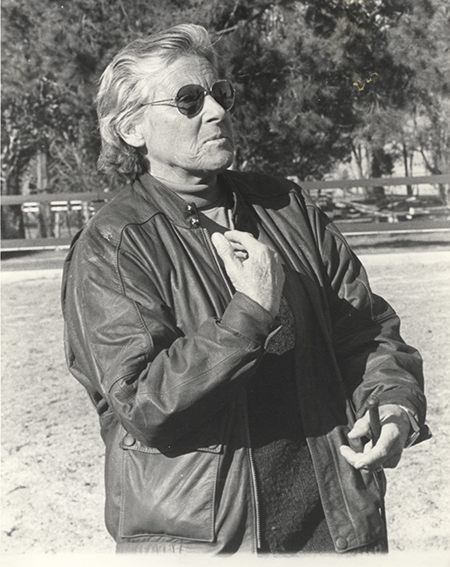



Tina was one of the great influences in my riding. Right up there with Bill and Wayne Roycroft. RIP Tina.
I had the good fortune of receiving lessons from Tina in the United States. I learned so much from her understanding of riding and method of teaching. As I would follow her instructions, I began to experience the work and joy of riding. Tina had a unique way of expressing herself and a good sense of humor. I am most thankful for a wonderful compliment she gave me after I completed a lesson where things went well. Tina looked at me with a smile and with a loud enthusiastic voice said: “You are absolutely wasted on the ground.” Tina was one of a kind and a true inspiration to those she taught.
..